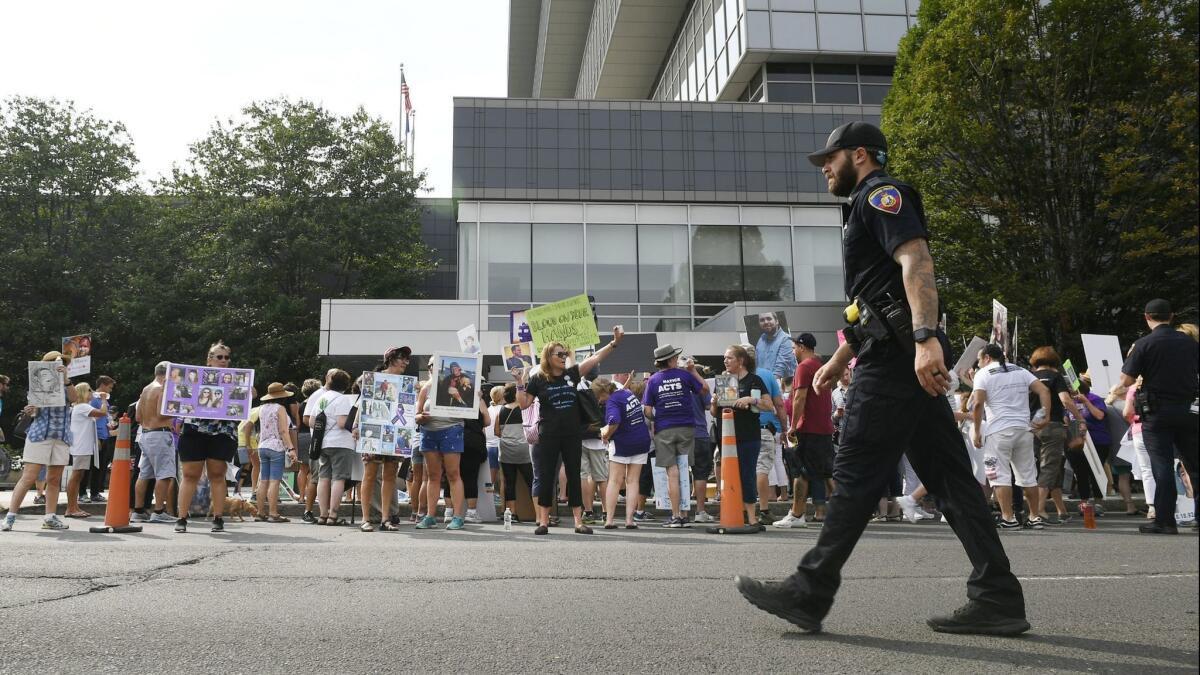Op-Ed: One of us was a pain patient saved by opioids, the other was addicted to them. We both deserve a solution

- Share via
Opioids have figured prominently in both our lives. For Kate, they were a lifeline after a surgical mishap left her unable to sit, stand or walk for more than a decade. For Ryan, they were a gateway to a dark decade of heroin addiction.
With overdose deaths at record highs, many Americans believe that we have over-treated pain at the expense of those who became addicted to prescription opioids. Increasingly, the media and politicians all but deny that pain exists, highlighting the blight of addiction and doing precious little to address either.
For too long, the two sides have been battling each other: Those whose lives have been ravaged by opioid addiction have a zero-tolerance approach to prescribing the drugs for pain. Those in serious pain, many of whom benefit from opioids, blame the crisis on those who misused the drugs and bristle at the increased barriers they now face in accessing their medication.
But blame helps no one. We have much in common. Our stories are two sides of the same pill. Serious pain and addiction are public health conditions that are widespread, stigmatized and misunderstood.
Our stories are two sides of the same pill. Serious pain and addiction are public health conditions that are widespread, stigmatized and misunderstood.
Persistent, daily pain affects one in six Americans, or 50 million people, according to government data. Forty million Americans experience severe pain, and almost 20 million live in disabling pain. Similarly, nearly 22 million Americans report a current substance-use disorder, an additional 23 million have recovered from one, and 2.6 million have a use disorder involving prescription or illicit opioids. The incidence of disabling pain and addiction is on par with cancer, heart disease and diabetes.
Yet only a few thousand doctors specialize in pain management in this country. According to a 2017 study, primary care physicians receive about 15 hours of pain education. Veterinarians, by comparison, get 85. And basic medical education about addiction is even worse, averaging only a few hours with only a few thousand dedicated physicians or psychiatrists who specialize in addiction treatment.
If history is any guide, we neglect both conditions at our peril.
Our focus on treating pain increased in the 1990s, but it was simplistic with an over-focus on opioids as a solution. Opioid addiction and overdose deaths were disregarded by society for far too long. Even now, despite increased awareness and public hand-wringing, our responses are inadequate. Naloxone, which rapidly reverses overdose, can be prohibitively expensive, and it’s not available over-the-counter in many locales. There are actual legal barriers to prescribing methadone and buprenorphine, which are evidence-based treatments for opioid use disorder, and access to affordable mental health and recovery treatment is abysmal.
People in pain have become the latest victims in this crisis, as regulatory efforts to curb prescribing have made it difficult if not impossible for them to receive opioids needed to manage their conditions. Physicians who fear liability are abandoning their patients or forcibly reducing or eliminating their medication. Even patients with cancer face barriers from insurance and pharmacy denials. As reporters have shown, when denied medication, patients may lose their ability to function, attempt suicide or resort to illegal substances.
Those who use opioids medically are often seen as “addicts in sheep’s clothing.” This perception has caused some in the pain community to position themselves in stark contrast with the addiction community, by embracing hashtags like #patientsnotaddicts that stigmatize people who are also suffering from a disease and face similar barriers to care.
The addiction community too can be quick to latch onto boogeymen, drawing a straight line from Purdue Pharma’s OxyContin to doctors who “hooked” their patients. Yet most people misuse diverted opioids, pills that were stolen or obtained from dealers, not pills that were prescribed to them by a doctor. Most overdoses do not result from a single medication but involve multiple substances (both legal and illicit). And the singular focus on pills belies what drives the overdose crisis today: illegally produced fentanyl, its analogs, heroin and, increasingly, cocaine.
Enter the Fray: First takes on the news of the minute »
This does not mean we shouldn’t hold Purdue or other pharmaceutical companies responsible where there is evidence of malfeasance and deliberate profiting from addiction. In fact, we should go further to question why we continue to allow aggressive marketing of controlled substances.
But accurately identifying who is at risk for addiction and overdose, which substances play a role, and exactly how they affect users matters because it shapes our policy solutions in ways that have real human consequences for people on both sides.
Comprehensive policy changes that address the dueling epidemics of serious pain and addiction in this country are sorely needed. The two sides in the battle over opioid use should band together and jointly work to effect cultural changes in how pain and addiction are treated. Anything less will only make already drastic consequences worse.
Ryan Hampton is the author of “American Fix: Inside the Opioid Addiction Crisis — and How to End It.” Attorney Kate M. Nicholson served for 20 years in the Department of Justice, where she drafted the current regulations under the Americans With Disabilities Act.
Follow the Opinion section on Twitter @latimesopinionand Facebook
More to Read
A cure for the common opinion
Get thought-provoking perspectives with our weekly newsletter.
You may occasionally receive promotional content from the Los Angeles Times.










